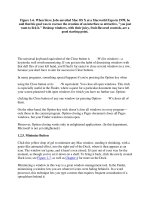Strategic Goals, Objectives, and Tasks How to Set Them and Then Make Them Happen
Bạn đang xem bản rút gọn của tài liệu. Xem và tải ngay bản đầy đủ của tài liệu tại đây (371.05 KB, 36 trang )
Strategic Goals, Objectives,
and Tasks: How to Set Them
and Then Make Them Happen
I
n this chapter I encourage you to stretch. You will move to anoth-
er level of sophistication by breaking out of planning creep or
incremental planning. What I propose is not risky to your business.
It is risky, however, to your psyche. This is the break point in the
storytelling. Here is where you find out if you actually mean to run
your business in a different manner than the ho-hum way of yes-
terday. Get ready to take the next step.
113
CHAPTER
5
H
OW TO
C
REATE
S
TRATEGIC
G
OALS
T
HAT
D
ELIVER
W
HAT
Y
OU
P
ROMISE
Vision should not be a stand-alone item. It works in conjunction
with the other parts of the business plan. The next step is to form a
goal-vision connection to introduce goals into the planning model.
It is common to treat vision and goals as separate units without a
relationship. This goal-vision disconnect is frequently found in
planning. A team develops a vision and somewhere later in the
agenda the team develops a set of goals. Seldom if ever does the
planning team ask, “If this is our vision, how can we define it in
terms of strategic goals?”
Translate your vision into something of substance by develop-
ing four or five strategic goals that collectively accomplish your
vision. Continue to build a logical story by adding these goal pieces
until a clearer picture of the future begins to emerge. Keep adding
parts and pieces that make sense until you have the whole plan.
This approach reminds me of a children’s story. It goes some-
thing like this: A man was wandering across the country and need-
ed to eat, but he had no money. He stopped in a village, but no one
would feed him, so he resorted to trickery. Producing a smooth,
round stone from his pocket he proclaimed it to be a magic soup
stone. Soon he convinced the villagers to boil a huge kettle of water
into which he dropped the stone. After letting it boil, he tasted the
water and declared it almost ready, but thought carrots were need-
ed to complete the taste. The villagers hurriedly found carrots to
add to the pot. Tasting the soup again the man declared it really
nice but just short of perfect. Perhaps potatoes were what it was
missing. By repeating this wily scheme over and over the man was
able to trick the villagers into putting enough ingredients into the
pot to make a rich soup from plain water. Planning is much like
making the soup. Start with a basic ingredient, but to make a real-
ly good company story add bold goals to give it character.
Goals are the measurable manifestations of the vision. When
you add your strategic goals together they should equal your vision
Seven Steps to a Successful Business Plan
114
(see Figure 5-1). By adding the goals you give measurement poten-
tial to the vision.
Strategic Goals, Objectives, and Tasks
115
Figure 5-1. Goals make up the body of the vision. They are the incre-
mental units of measure to accomplish the vision.
A powerful vision without concrete definition and measure-
ment abilities is a dream, fantasy, or delusion. It might even grow
into a nightmare. Too often it translates into unfulfilled expecta-
tions for employees, bitter disappointment for those who failed to
accomplish their plans, and distrust by the board of directors of
those managers who promised so much. The bottom line is that
everyone is tired of promises. Employees have been promised great
returns if they just work harder. Managers work to make the num-
bers and are then disillusioned when executive decisions thwart the
plan. Failure is created by influences outside the managers’ control.
Boards of directors were promised certain levels of performance
from the president. In turn, they promised shareholders to share
the riches. Boards do not like to go back to shareholders with an
“oops.” Expectations are not properly managed in situations where
planning has failed.
Diagramming Your Vision: Tips on Structuring
Your Goals
Because the vision is sometimes vague or fragmented, we use goals
to bind it together to give it a level of cohesiveness. Because it is
made up of hidden but concrete components, a reverse engineering
process can be used to understand the vision and formulate the
goals. Remember diagramming sentences in English class? Breaking
a sentence into components? Diagramming a vision works the
same way to determine what is measurable and concrete.
Let’s take Henry Ford’s vision as our practical case exercise
because we have a frame of reference for the company’s successes
and failures. Obviously we could reconstruct the company, but let’s
not do that. Instead, we can apply what we have learned so far from
this book, our common business sense, and our intellectual capaci-
ty. Imagine Henry Ford as he might have mused over coffee: “Let’s
see, I’ve got my vision and my mission. What goals will make my
dream come true? How can I hold off that guy Sloan over at General
Motors?”
Ford’s Vision Statement (Actual)
“I will build a motor car for the great multitude. It shall be large
enough for the family, but small enough for the unskilled individ-
ual to easily operate and care for—and it shall be light in weight
that it may be economical in maintenance. It will be built of hon-
est materials—by the best workmen that money can hire—after the
simplest designs that modern engineering can devise. But it shall be
so low in price that the man of moderate means may own one—and
enjoy with his family the blessings of happy hours spent in God’s
great open spaces.”
1
Ford’s Mission Statement (Hypothetical)
The mission of Ford Motor Company is to put Americans on
wheels.
Seven Steps to a Successful Business Plan
116
“If those are my anchor points, my mission, and my vision, I
need concrete, measurable goals,” he might have said.
Ford’s Strategic Goals (Hypothetical)
Henry Ford might have then come up with these three strategic
goals:
1. Become the number-one selling automobile maker in
America.
2. Become the standard motor car for the American public.
3. Build a low-cost, high-quality line of cars that attracts a
significant portion of the potential American buying pub-
lic.
Those three goals inherently include key elements to make his
vision a reality. They say a lot and address major elements such as:
■ Market position (number-one selling automobile)
■ General market (American buying public—great multi-
tudes)
■ Targeted market (family)
■ Sales territory (America)
■ Industry position (the standard motor car)
■ Product differentiation (low cost, high quality)
Just to dream would not make the future happen. There had to
be more. Consider how Henry Ford may have used the goals to
connect his vision with reality. Ford knew that the key to his suc-
cess lay in the ability to mass-produce cars. He knew what he want-
ed in terms of the final product. By taking a hard-hitting approach
he could make his vision happen. Nor was he distracted in devel-
oping his product. There was such a demand for the basic product
that Ford knew the manufacturer that got the cheapest mass-pro-
duced car to the market would be the winner. This is probably what
Strategic Goals, Objectives, and Tasks
117
prompted him to state, “Any color you want, so long as it’s black.”
2
He was too busy filling orders to be worried about something as
insignificant as a customer’s preference of color. In those market
conditions at that time, it was an effective decision.
H
OW TO
T
RANSLATE
Y
OUR
V
ISION
I
NTO
R
EALITY
A vision with corresponding goals is still not enough to get from
the theoretical to the practical. Astute business leaders know that
every business has a core function or a “locus of control.” Henry
Ford clearly understood this concept with his manufacturing line
techniques. Sam Walton certainly understood that a more effective
distribution system was needed to change the retail model.
3
The
late Ray Kroc of McDonald’s grasped the concept when he devel-
oped the formula for his franchise system. Michael Dell of Dell
Computer Corp. had insights to change the marketing and sales of
computers long before the rest of the industry caught up.
Ford was building more than motor cars. He placed his product
into a context of a higher order or meaning. He was completing a
dream by reaching out to the common man. Buying a Ford auto-
mobile placed the average person in the same league with the aris-
tocrats. Both could move from the old-fashioned horse and buggy
into the modern era together. Henry Ford was a true visionary who
painted the future in bold strokes and forever changed an industry
and a nation. Likewise Sam Walton, Ray Kroc, and Michael Dell
each gave us a world today that could have been significantly dif-
ferent without their abilities to envision the future and set bold
goals.
Painting Your Story With Bold Strokes
Your story must be painted both in the spoken and printed word
with a breathtaking boldness. You started that boldness in the
vision and must continue in a fashion that moves the painted pic-
Seven Steps to a Successful Business Plan
118
ture from one of potential to probable. Translating a vision into
reality is achieved by developing strategic goals that are more than
an extension of your current behavior. Strategic goals must be a
stretch, otherwise they defy the definition of strategic. They must
take you into an area that cannot be supported with the compla-
cent management behavior found in most organizations. These
goals must add a challenge that management teams and employees
find stimulating. The magnitude of the goals must be challenging
but not absurd. While the ability to reach the goals must be a
stretch, it should not be an impossible feat. The freshness of your
goals must break management out of complacency but not kill the
team spirit in the process.
T
HREE
S
TEPS FOR
S
ETTING
B
IG
, B
OLD
G
OALS
Routine goals meet the requirement, but not the spirit, necessary to
generate the passion found in the field of vision. Most of you will
set routine goals by natural reaction. To fire up a story and get
employees’ energy flowing, the goals must be far more than rou-
tine. They must be blatantly bold.
4
This boldness is sometimes dif-
ficult for timid management to grasp. A team from a $150 million
company may find it difficult to set a goal of growing to $1 billion
in revenues in ten years. A complacent team may find a stretch goal
of reducing quality issues tenfold in three years just a touch
demanding. Life in most organizations is tough enough without
adding more work. Comfort is the leveling factor. To suggest bigger
goals, which immediately suggests more effort, is a little discom-
forting to the people who must implement. When challenged to
change existing behavior, the natural reaction is to resist. Great
courage is required to break the bonds of normal behavior and
reach for seemingly impossible performance.
Courage to set bold goals comes from pure, old-fashioned lead-
ership. A manager can calculate the numbers and figure the odds. A
manager can perform a risk analysis and make the appropriate deci-
sions. Those are necessary but not enough to carry the day.
Strategic Goals, Objectives, and Tasks
119
Leadership is necessary to energize the spirit and galvanize the bold
goal setting. I’ll not go into the parameters of leadership except to
say it is a responsibility of leaders to step to the forefront by creat-
ing stretch goals.
Step 1: Fire Up the Management Team
Big, bold goals don’t just happen. The norm is business as usual, so
you need a way to set bolder levels of sustained performance. Two
methods can be used to establish big, bold goals. One way is to fire
up your management team. This takes energy, leadership skills, and
time commitment. Being a cheerleader for the kind of group
dynamics capable of producing a big, bold goal is tough on the
leadership capability of any manager. A law of physics provides a
useful illustration: Bodies at rest tend to stay at rest. This law of
inertia implies that teams that set unimaginative goals will contin-
ue to set unimaginative goals. Tremendous management energy is
required to break the inertia. Leaders trained in group dynamics can
be successful in using the potential synergy of group membership.
Step 2: Get Leadership to Step Up to the Plate
A second way to generate a big, bold goal is to have the executive
leadership initially set the requirement. This forces your manage-
ment team to step up to the plate and take a swing at the ball. The
team cannot be sitting in the bleachers watching the president
pitch while the employees play the outfield. The management team
must assume the responsibility for carefully analyzing the organi-
zation’s potential and determining exactly what level of goal
achievement is possible.
Here the quality of your management team comes into play.
You need team members with experience, wisdom, and judgment.
There is a correlation between high-performing team members and
good planning. Expect and demand all your planners to come pre-
pared to make decisions on their professional opinions as well as
data from their respective specialties.
Seven Steps to a Successful Business Plan
120
Step 3: Validate Your Strategic Goals
In setting such high expectations leaders have psychologically com-
mitted to making the goals happen. To counter the problem of
employees not trusting the goals, management must make an open
sign that the goals are real. The best visible sign that a goal is to be
taken seriously is the allocation of resources to that goal. You can
talk and talk and talk, but the fact is that you are going to have to
commit to the goals. There must be genuine dedication of resources
to make big, bold goals a possibility.
Another technique is the designation of responsibility and
accountability for the success of the goals. Goals are looked at with
a more critical eye if people realize early in planning that they will
be held accountable.
In working through the details of the strategic plan there must
be validation of the strategic goals through the use of data. Market
trend analysis, customer surveys, professional reports, and other
reports are sources of critical information. You base goals on the
synthesis of these pieces of information. Adding a dash of good old-
fashioned intuition is also acceptable after you have done your
homework. Don’t ever go into a planning session with a blank
sheet of paper, throw up some numbers, and expect to be success-
ful. Wild, unsubstantiated numbers turn people off. You counter
panic by calmly demonstrating mastery of the facts. One reason
that big, bold numbers are not used is that managers are too lazy to
do the analysis to determine the potential. It is too convenient to
fall back on the industry average. Those numbers are easy to deter-
mine and the supporting numbers are equally easy to fabricate. It is
hard work to do risk assessment, potential assessment, and proba-
bility analysis.
A distinct difference is found between an organization that
throws around big numbers without a chance of achieving them
and one that sets huge goals with determination to succeed.
Unrealistic numbers paralleled by management systems unable to
achieve the goals is an impossible situation. Often a management
team sets unrealistic numbers believing they are following the con-
Strategic Goals, Objectives, and Tasks
121
cept of bold goals. There is no real examination of the future.
Scenarios are not examined, markets are not analyzed, and revenue-
generating income streams are unrealistically calculated. As these
bogus numbers are communicated to the workforce, apathy quick-
ly becomes the norm. Unexplained, unrealistic numbers are the
death knell to morale and your plan.
S
EVEN
C
RITICAL
Q
UESTIONS TO
A
SK
W
HEN
S
ETTING
G
OALS
Here are critical questions you can ask when you have finished your
analysis and are trying to set the goals. Begin with this fundamen-
tal question—Why do we want to accomplish this goal?—then ask
the other seven questions:
1.
Attainability. Can the desired end product really be accom-
plished or achieved now that I have looked at all the facts
and figures?
2.
Management Ability. Will it be possible for the company to
build a series of actions and decisions over the lifespan of
the plan to complete the goal?
3.
Products, Goods, and Services. Do we have enough of each
to reach the goals?
4.
Core Competencies. Are we skilled enough to reach the
goals? What skills will we need in the future that we don’t
have now?
5.
Intellectual Capital. Do we have the native intelligence to
reach our goals? Are we using all the “smarts” of our peo-
ple? What will we have to change to increase our usage of
intellectual capital?
6.
Work Ethic. Are we willing to work hard, make the extra
effort, and commit 110 percent to reaching our goals?
Isn’t it just easier to stay in the comfortable middle than
to put all this energy into big, bold goals?
Seven Steps to a Successful Business Plan
122
7. Market Potential. Is the existing market big enough to
allow us to reach our dollar requirements? How do we get
more market share?
If the answers to these central questions are yes, then your plan
is on track. If the answers are no, then you have another series of
problems. If you answered no, you must go back through the plan-
ning process to resolve the problems. A number of possible solu-
tions exist:
■ Reexamine your assumptions. Have you mixed facts with
assumptions? By changing your assumptions you may
change your goals.
■ Revisit your mission statement. Look carefully at your speci-
fied task and the implied tasks. Is your mission still valid
or did you miss the basic question—What business am I
in?
■ Reexamine your data. Are you looking at real data or emo-
tional positions?
H
OW TO
C
ONSTRUCT
R
EALISTIC
G
OALS
While goal setting has certain logical steps, it really begins in a
more loose fashion. Having facilitated hundreds of goal-setting
sessions over the years, I see a pattern emerge that generally looks
like this:
■ Get a group discussion started. Begin the discussion with a
simple question: What will it take for us to reach our
vision? In profit organizations, the first element to surface
is growth. This is usually stated in terms of gross sales.
After some discussion the goal expands to multiple goals
(such as gross sales and profit) when the group comes to
understand that the first goal is not well thought-out.
Strategic Goals, Objectives, and Tasks
123
■ Get something on the board. Put the first goal (usually gross
sales) on the board and discuss the scope and scale of the
goal. Here is the time-consuming part of your planning
session. Getting agreement on the goal is sometimes diffi-
cult if the group is not aligned. There is a belief among
consultants that reaching agreement on a ten-year goal is
more important to the success of the plan than the actual
number itself. Remember, the number may change, but
you need immediate commitment from the team toward
the goal no matter what the specificity.
■ Get another goal on the board. Once a solid goal has been
established it becomes easier to fill in goals two through
five (arbitrary numbers for illustration purposes). Move
the group discussion to the next most important goal
from a list of potential topics such as market share, prod-
uct release, and customer satisfaction improvement. These
are topics drawn from the vision.
■ Finish the goal list. Work through the vision topics until
the group is satisfied that the list is comprehensive.
Remember the rule of thumb that four or five strategic
goals are enough to make the vision complete. The team
should ask the question, “Do these goals make our vision
happen?” When the answer is yes, stop the goal-setting
process and move on.
Realism is achieved in your bold goals by looking at the cold,
hard facts of your industry and your organization’s situation.
Consider the diagram in Figure 5-2. Before we go too far with this
example, let’s explain the parameters. I use a financial goal of gross
sales because it is the easiest one for most businesspeople to com-
prehend. I could have easily substituted another goal. The steps of
describing this financial goal can and must be replicated with other
competing goals.
Seven Steps to a Successful Business Plan
124
In Figure 5-2, let’s assume you are at point A at year-end 2000,
with $50 million in gross sales. Assume you are in a stable market
and have a 15 percent market share. Since you use planning creep
as a model and industry growth is 10 percent, you intend to stay
even. If you do what you have always done you will only stay even.
This puts you at point B in ten years, which roughly calculates to
$130 million in sales. You creep toward the future by extending the
existing model outward and are pleased with the numbers.
Now let us assume you used the backPlanning model (see
Chapter 3) and realize that $130 million in ten years will not per-
mit you to achieve your vision or realize your dreams. You recon-
figure the model to within a target of $500 million in ten years. To
move from $50 million to $500 million is a big move. The problem
is the saying, “You can’t get there from here.” We often know where
we want to go but can’t seem to make it happen without changing
some of the fundamental ways we do business. How tantalizing it
must be to see success just out of reach.
Strategic Goals, Objectives, and Tasks
125
Figure 5-2. Bold goal setting avoids planning creep (A–B), establishes
high expectations, and requires stretch from the workforce (A–C).
However, you can break out by asking and answering hard
questions. For example, if you are a $130 million company in a $10
billion industry you have just stayed even. If your strategic goal is
to become a $500 million company in that industry, you have some
growth to accomplish. We could get into a huge presentation about
market shares and the accompanying good or evil examples, but we
won’t. This is not a marketing strategy book.
You may decide to move to $500 million by capturing market
share. It is your call. Just remember: To gain market share, someone
has to give it up. If the market is valuable, your competitors won’t
give it up easily. If the market is declining, your competition may
readily give you all the market share you want. Be careful basing
great successes on grabbing market share. Your story can become
significantly flawed if you base it on size of market share.
F
OUR
D
OWNSIDES TO
U
SING
M
ERGERS AND
A
CQUISITIONS AS A
G
ROWTH
T
OOL
When the financial goal falls short of the desired number, mergers
or acquisitions should not be used to fill the difference and round
out the plan. The tendency to use an acquisition to make the num-
bers is a dangerous flaw in thinking. Repeatedly we see the use of
an acquisition as a planning convenience. This gets the team off the
hook of explaining how they plan to make up the long-term goal.
This is either an avoidance behavior by management to avoid the
planning pain or just capricious business behavior.
Given what is known about mergers and acquisitions failures,
this avenue of revenue must be given careful thought. A wealth of
intellectual capital exists on the problems of bringing two organi-
zations together. The information is very clear. Billions of dollars
are spent annually on acquisitions with very little return. In fact,
the lost ground is a hidden cost that needs to clearly be studied,
published, and taken to heart. Yet we read the papers daily and find
fanfare and much-heralded stories of mergers and acquisitions.
Seven Steps to a Successful Business Plan
126









